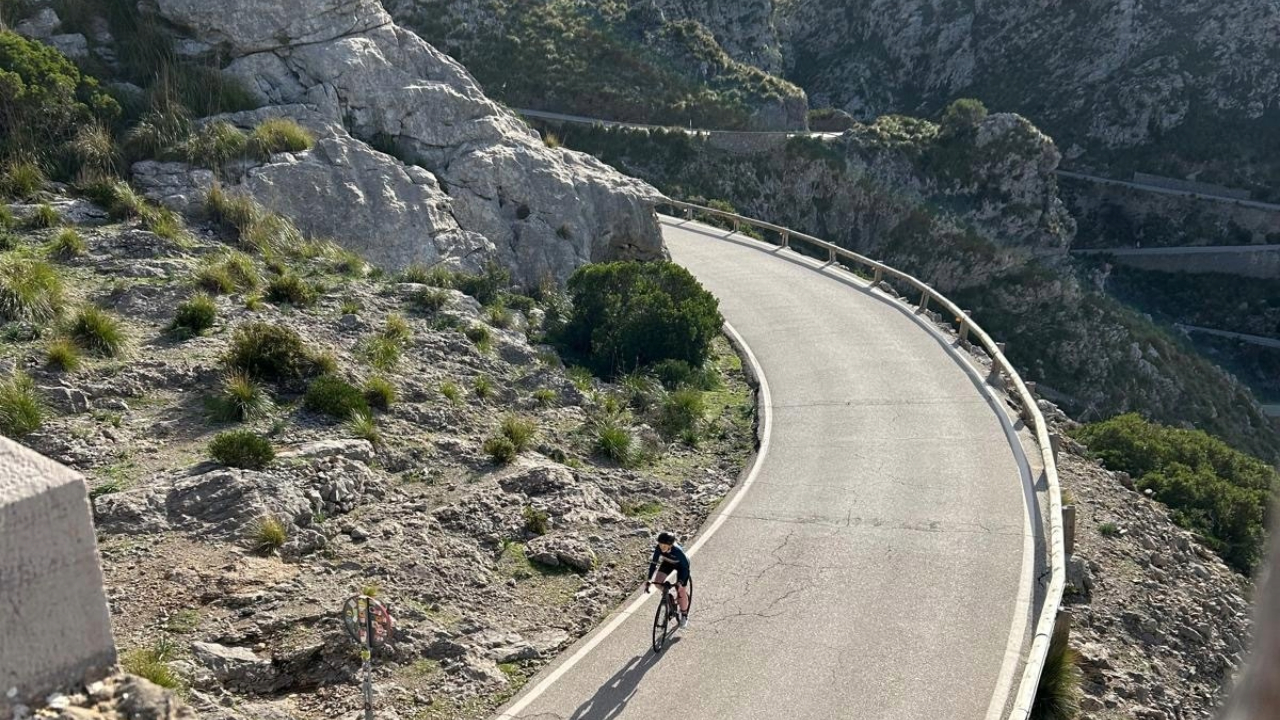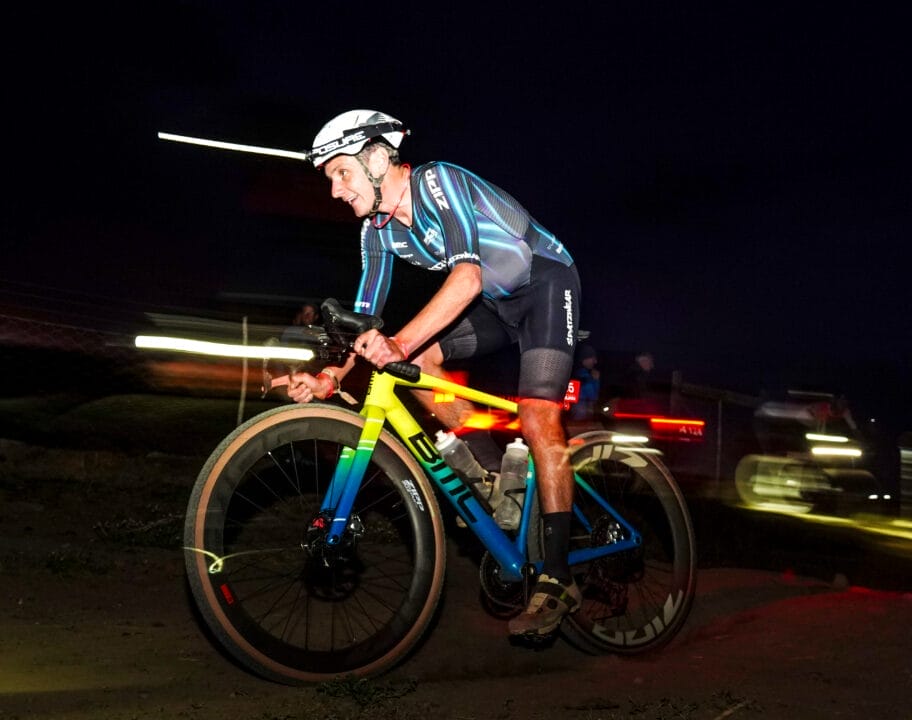Whether you’re setting up your avatar on ROUVY, or getting caught in the middle of an “I’ll show you mine if you’ll show me yours” discussion on the Sunday café ride. Once you roll into the world of cycling, it’s almost impossible not to stumble across chatter about FTP. And, if you’re yet to tumble fully into the depths of the cycling data rabbit hole (or maybe that should be pothole), you might be wondering what on earth FTP means – and if it’s something you should care about.
I’ll guide you through what FTP means, when it can be useful and how to use your data to dial in your bike training.
What is FTP?
FTP stands for Functional Threshold Power. In cycling, power means the amount of force you’re pushing through your pedals. We express this in watts. The more force you put through the pedals, the faster you’ll ride – but you’ll also be expending more energy. A lot of bikes these days come with power metres built into the cranks or the pedals. And pretty much all smart turbo trainers and indoor bikes will measure your power output.
Your cycling FTP quantifies the maximum amount of power you could theoretically hold – i.e., how ‘hard’ you could ride – for one hour. If you were to ride at this effort, you’d pretty much be at your limit by the end of the 60 minutes. Your FTP typically aligns with your second lactate threshold – the point at which your body is using carbohydrate as the predominant fuel source and lactate is starting to significantly accumulate in the blood. Essentially what that means is that riding at your FTP power for one hour would be physically and mentally very tough. So it’s not a number you’ll ride at frequently in training, but it can be used as a bench mark to work back from to calculate what intensity you can realistically work at for any given amount of time on the bike.
Does FTP actually matter?
The answer to this question really has to be ‘it depends’. If you’re someone who simply wants to enjoy going out on your bike, you tend to ride at a nice low intensity and you’re not interested in ticking off specific training sessions or particularly bothered about cycling performance. You probably don’t need to know about your FTP. There might be scenarios where it’s useful – for example, if you struggle to go beyond a certain distance without blowing up you could use your FTP data to make sure you’re riding at an appropriate intensity for the required distance and your fitness levels. But you could also use heart rate for that. So if you’re quite happily ticking along on your weekend explores and the thought of eyeballing data would take the joy out of riding for you. Honestly? I’d tune out the FTP chat and ride on.
Why FTP can be useful
Knowing your FTP can, however, be useful if you’re focused on improving your cycling performance and/or if you’ve got a specific event you’re training for. Primarily FTP is a way to measure, quantify and benchmark your cycling fitness. As you get stronger and your aerobic fitness improves, you’ll be able to hold a higher power before you hit your second lactate threshold. Your FTP will be higher, which means you’ll be able to ride faster for longer.
But beyond giving you a line in the sand to see where your cycling fitness is at, and a way to track your progress. Your FTP is also a useful metric to make sure you’re riding at the correct intensity during your bike workouts and training rides. You can set yourself a target power to hold using a percentage of your FTP, depending on the desired training effect of a workout or the duration of a ride.
How to use your FTP data
For example, let’s say you’ve got a bike workout where the aim is to complete longer intervals in Zone 3 to improve your endurance pace – you would want to be working at between 75-90% (depending on fitness) of your FTP. Knowing what your FTP is means you can set specific targets, rather than relying on riding to feel.
In training, using % of FTP to set specific intensity targets means you can get really precise with the energy systems you’re working, and get the most quality out of every training hour.
If you’re a time trial rider completing anything above a 25 mile TT, you can start to use your FTP to set a race pace intensity that will allow you to get everything out of yourself – without blowing up. You might be able to get away with a ‘go as hard as possible and cling on for dear life’ strategy in a 10 miler. But once you get to 25s, 50s and beyond – having a power plan becomes more critical.
Using your FTP data can also be handy for sportives or big days in the saddle. You can set yourself a target average and a ‘ceiling’ power for any climbs to make sure you avoid going too deep into the red and work at an intensity you’ll be able to sustain all day long. We’ve all at least once (most of us several times) gone off like we’re a Tour de France rider in the first hour of a long ride, only to pop shortly afterwards and spend the next 4 hours exhausted, barely able to turn the pedals and regretting our over-optimistic hour one life choices. Knowing exactly what effort you can sustain – and sticking to it – can help to make the long rides so much more enjoyable.
How do I find out what my FTP is?
Your FTP will change as your cycling fitness increases or decreases. So you’ll probably need to do an FTP test at least a couple of times a year to keep your zones and targets up to date. Many cyclists will do an FTP test at the start of a training block to set a benchmark, and then re-test after an 8 week block to track their progress and adjust the intensity of their training to keep stimulating adaptations.
If riding as hard as you possibly can for 60 minutes sounds certifiably Not Fun. The good news is, there are other shorter and ever so slightly less gruelling methods of measuring your FTP.

20 minute FTP test
The most common form of FTP test is the classic 20 minute power test. After a good warm up (trust us, you don’t want to go in cold!) you need to ride as hard as you can at a sustained power for 20 minutes. It’s tough – but at least it’s over relatively quickly. You then take the average power you held for 20 minutes and multiply that number by 0.95 to get your 60-minute FTP. Platforms such as ROUVY have dedicated FTP tests in their workout libraries, which take care of all the maths for you.
Ramp test
If the idea of having to grit your teeth and bear it for 20 minutes doesn’t sound appealing. The other option is a ramp test. As you might guess from the name, a ramp test involves starting at an easy power output and ‘ramping’ up in set power increments every minute until you reach failure. Once you’ve hit the wall, the highest power you were able to hold for 1 full minute is multiplied by 0.75 to calculate your estimated 60-minute FTP. Again, you can complete specific ramp test workouts on indoor cycling platforms which will tell you what power to target and take care of the calculation.
1 hour hill climb

For those who really can’t stand the turbo trainer, you can also take your FTP test out into the real world – as long as your bike has a power metre. Finding a route where you can hold a consistent power for a full 60 minutes without being interrupted by traffic or junctions is difficult. But if you’re lucky enough to live somewhere with some epic climbs, finding a hill that will take you around an hour to ascend is a great way to get your FTP. The added motivation of riding towards the top of the climb can make it easier to keep pushing compared to doing it on the flat or on the turbo trainer. Excuse for a cycling holiday, anyone?
Don’t compare your FTP number to another riders
One final thing to note, is that unless you are the exact same height, weight and build as another rider. Comparing FTP numbers is pretty pointless. Despite how much people love to brag about theirs! Your FTP number only tells one part of the story. Because in cycling it’s really the power to weight ratio (expressed in watts per kg) that typically influences how fast you’ll ride – especially up hills.
A lighter rider might have a lower FTP number compared to a heavier rider, despite having similar aerobic fitness. But if that lighter rider is operating at 5 watts per kg, while the heavier rider is at 4 watts per kg – the rider with the lower FTP number would be getting up a hill faster. We can take a deeper dive into watts per kg another time. But the key takeaway here is this: “comparison is the thief of joy” is a cliché for a reason. Use FTP to benchmark your own progress. But don’t waste precious sweat over anyone else’s numbers.




